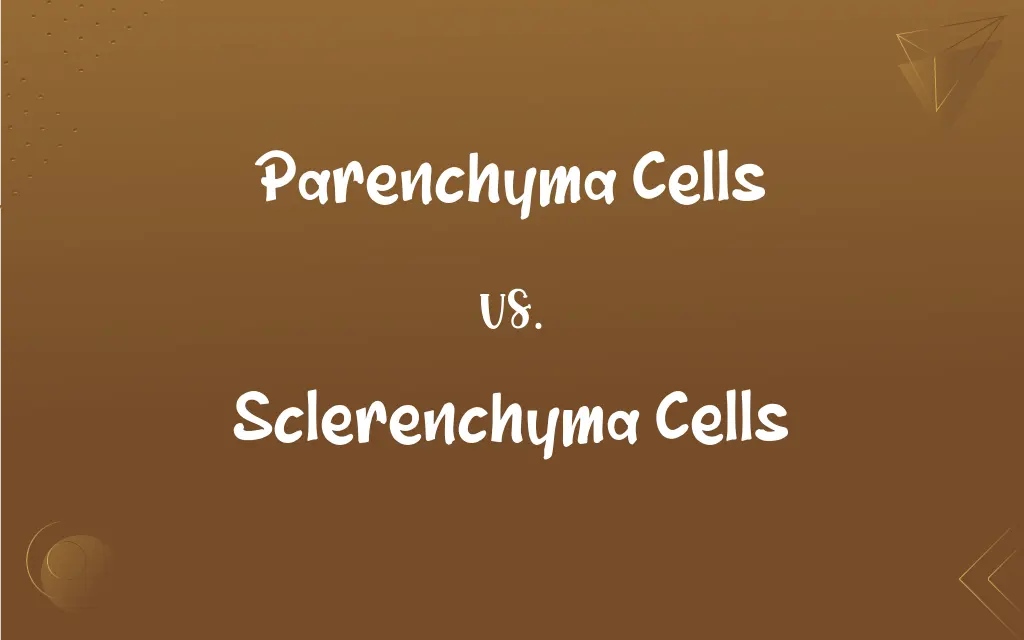Parenchyma Cells vs. Sclerenchyma Cells: What's the Difference?
Edited by Aimie Carlson || By Janet White || Published on March 28, 2024
Parenchyma cells are primary, living plant cells with thin walls for storage and photosynthesis; sclerenchyma cells are thick-walled, dead cells providing support and strength.

Key Differences
Parenchyma cells have thin, flexible cell walls and are living cells, often involved in photosynthesis, storage, and tissue repair. Sclerenchyma cells have thick, lignified cell walls and are usually dead, providing structural support to the plant.
Parenchyma cells play a role in storage, secretion, and photosynthesis in plants. Sclerenchyma cells function mainly in mechanical support, rigidity, and strength.
Parenchyma cells are found throughout the plant, including leaves, stems, roots, and fruits. Sclerenchyma cells are typically located in regions requiring extra support, such as stems, leaf veins, and seed coats.
Parenchyma cells can divide and contribute to plant growth and healing. Sclerenchyma cells, being dead, do not contribute to growth but provide rigidity and resistance to bending and breaking.
Parenchyma cells often contain chloroplasts for photosynthesis, while sclerenchyma cells lack such organelles, focusing instead on structural support.
ADVERTISEMENT
Comparison Chart
Cell Structure
Thin, flexible cell walls; living cells
Thick, lignified cell walls; usually dead cells
Functionality
Involved in storage, photosynthesis, secretion
Provide mechanical support and strength
Location in Plants
Throughout the plant body
In areas requiring structural support
Growth and Development
Can divide and contribute to growth
Do not divide; provide rigidity and resistance
Cell Composition
Often contain chloroplasts
Lack chloroplasts; focus on structural support
ADVERTISEMENT
Parenchyma Cells and Sclerenchyma Cells Definitions
Parenchyma Cells
Parenchyma cells play a key role in plant tissue repair and regeneration.
After pruning, parenchyma cells help in the regrowth of plant branches.
Sclerenchyma Cells
Sclerenchyma cells are found in regions like seed coats and leaf veins.
The veins in leaves owe their strength to sclerenchyma cells.
Parenchyma Cells
Primary plant cells with thin walls involved in storage and metabolism.
The fleshy part of an apple is made up of parenchyma cells.
Sclerenchyma Cells
Dead cells that strengthen and support mature plant areas.
Sclerenchyma cells in the stem help plants stand upright.
Parenchyma Cells
Cells that constitute the bulk of plant tissues, including fruits and leaves.
The soft tissue in potato tubers consists mainly of parenchyma cells.
Sclerenchyma Cells
Non-living cells that contribute to the plant's mechanical strength.
The fibrous strings in celery stalks are composed of sclerenchyma cells.
Parenchyma Cells
Flexible, living cells that can divide and adapt to various functions.
Leaf mesophyll, filled with parenchyma cells, is crucial for photosynthesis.
Sclerenchyma Cells
Thick-walled, lignified cells providing structural support to plants.
The hardness of walnut shells is due to sclerenchyma cells.
Parenchyma Cells
Cells capable of storing nutrients and water in plants.
The juicy segments of an orange are parenchyma cells storing juices.
Sclerenchyma Cells
Cells with heavily fortified cell walls, aiding in plant rigidity.
The toughness in pear fruit is partly due to sclerenchyma cells.
FAQs
What are parenchyma cells?
Living primary cells with thin walls, involved in various plant functions.
Can parenchyma cells undergo cell division?
Yes, they can divide and contribute to plant growth and healing.
Where are parenchyma cells located in plants?
Throughout the plant, including leaves, stems, roots, and fruits.
What makes sclerenchyma cells rigid?
Their thick, lignified cell walls.
Are sclerenchyma cells alive?
No, they are usually dead at maturity.
What are sclerenchyma cells?
Thick-walled, dead cells that provide support and strength to plants.
Where are sclerenchyma cells typically found?
In areas requiring extra support, like stems and leaf veins.
Can sclerenchyma cells change their function?
No, their function is fixed as structural support.
What is the primary function of sclerenchyma cells?
To provide mechanical support and strength.
Are parenchyma cells involved in storage?
Yes, they often store nutrients and water.
Do sclerenchyma cells contribute to plant growth?
They do not contribute to growth but provide structural integrity.
Do all plants have parenchyma cells?
Yes, they are common in all plants.
Do parenchyma cells have a role in photosynthesis?
Yes, especially those with chloroplasts in leaves.
How do parenchyma cells aid in plant repair?
They can regenerate and heal damaged plant tissues.
What differentiates sclerenchyma cells from other plant cells?
Their thick walls and role in providing rigidity.
What type of cell walls do parenchyma cells have?
Thin and flexible cell walls.
How do parenchyma cells contribute to a plant's flexibility?
Their thin walls allow for flexibility and adaptation.
Are sclerenchyma cells essential for plants?
Yes, for structural support and protection.
What substances are stored in parenchyma cells?
Water, starch, and various nutrients.
How do sclerenchyma cells affect the texture of plant tissues?
They often make the tissues tougher and less flexible.
About Author
Written by
Janet WhiteJanet White has been an esteemed writer and blogger for Difference Wiki. Holding a Master's degree in Science and Medical Journalism from the prestigious Boston University, she has consistently demonstrated her expertise and passion for her field. When she's not immersed in her work, Janet relishes her time exercising, delving into a good book, and cherishing moments with friends and family.
Edited by
Aimie CarlsonAimie Carlson, holding a master's degree in English literature, is a fervent English language enthusiast. She lends her writing talents to Difference Wiki, a prominent website that specializes in comparisons, offering readers insightful analyses that both captivate and inform.































































